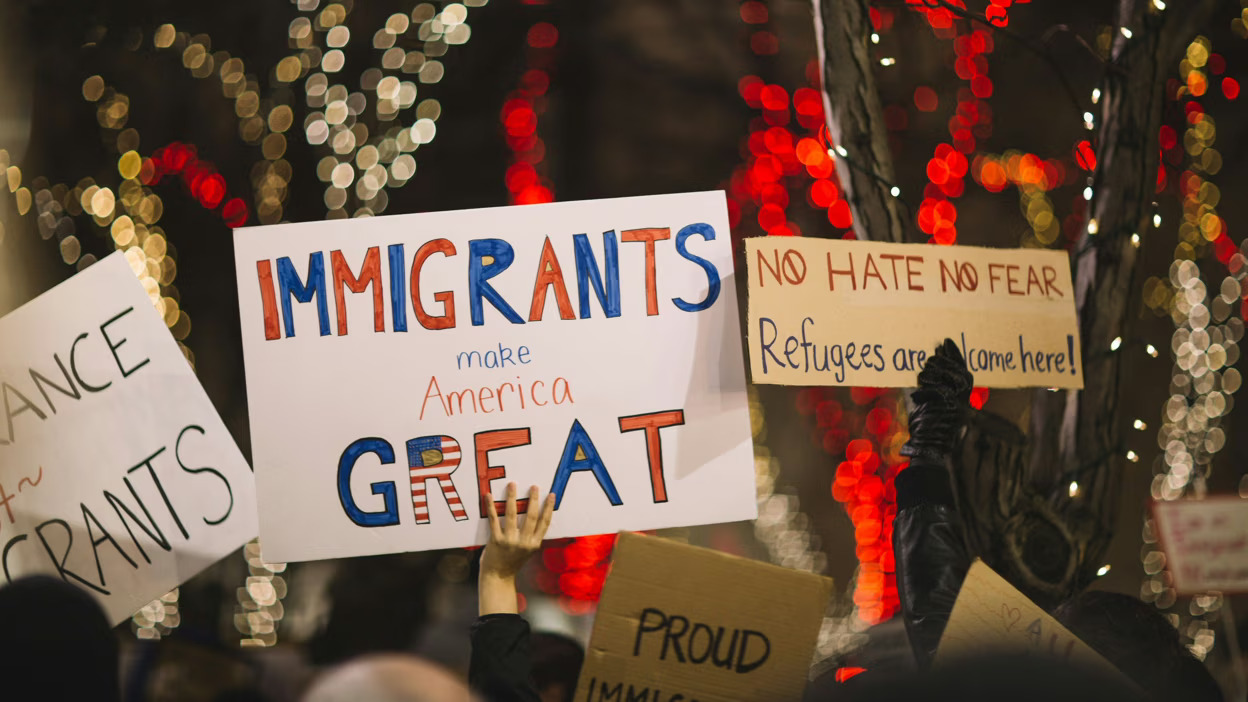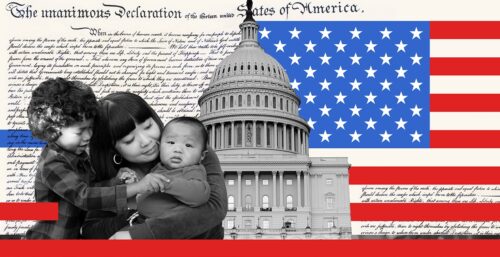IN THIS REPORT
- Executive Summary
- Introduction
- Which countries did the June 2025 travel ban target?
- What are the stated justifications for the travel ban?
- How many visas were issued to the affected countries?
- What was the impact of the previous travel ban?
- What could be the direct economic impact of the June 2025 travel ban?
- What could be the indirect impact on the broader immigrant population and the U.S. economy?
- Conclusion
Executive Summary
On June 4, 2025, the Trump administration announced a new travel ban targeting 19 countries. This marks a significant expansion of the travel bans President Trump issued during his first term, and reflects a more aggressive use of the president’s authority to limit the entry of foreign nationals who would otherwise qualify to come to the United States. Media reports have confirmed the administration is weighing imposing restrictions on 36 additional countries—primarily in sub-Saharan Africa.
Banning immigrants from these countries, many of whom come to the United States to reunite with family, will cause hardship and emotional stress for them and their relatives. Because many also come to study or work, it will also lead to major disruptions in higher education, labor markets in essential U.S. industries, and tax revenues and consumer spending.
The targeted immigrant groups hold significant economic clout, and the travel ban will have adverse impact on local businesses and communities across the United States. This report analyzes the scope, stated rationale, and consequences of the June 2025 travel ban, drawing on recent and historical data to assess its potential impact on the U.S. economy and on American communities and families.
Make a contribution
Make a direct impact on the lives of immigrants.

Which Countries Did the June 2025 Travel Ban Target?
The June 2025 travel ban is concentrated on two regions of the world: the Middle East and North Africa; and sub-Saharan Africa. The five countries covered by the new bans (full or partial) in the Middle East and North Africa are home to 45 percent of the region’s population. The eight countries affected by full or partial bans in sub-Saharan Africa are home to 6.4 percent of that region’s population.
Additionally, the administration has signaled it may further target sub-Saharan Africa for future travel bans. Twenty-four of the 36 countries that have been identified as future ban candidates are in sub-Saharan Africa. If all 24 were to be hit with bans in the future, an additional 71 percent of the region’s population would be affected.
How Many Visas Were Issued to the Affected Countries Last Year?
In fiscal year (FY) 2024, the U.S. government issued 161,987 visas in categories that would be subject to the June 2025 travel ban. These included both immigrant and non-immigrant visa categories, such as tourist and temporary worker visas, and were led by visas issued to nationals of Venezuela, Iran, and Cuba.
Half of the immigrant visas issued in the categories affected by the June 2025 travel ban, 12,738, were for extended family members of U.S. citizens and lawful permanent residents, including adult children and siblings of U.S. citizens and spouses or unmarried children of lawful permanent residents. The next largest numbers were for diversity visas and employment-based visas.
Of the non-immigrant visas in the affected categories, 86.5 percent were for tourists and business travelers, followed by students (7 percent) and commercial sea or international airline crewmembers (2.6 percent).
What Was the Impact of the Previous Travel Bans?
The number of immigrant visas issued to the six countries most affected by the Trump administration’s previous travel bans—Iran, Libya, North Korea, Somalia, Syria, and Yemen—dropped by 69.9 percent between FY 2016 and FY 2019, with Iran and Somalia seeing the biggest declines.
The number of non-immigrant visas issued for these six countries plunged even further, by 84.7 percent, between FY 2016 and FY 2019, led by Libya and Yemen.
What Could Be the Direct Economic Impact of the 2025 Travel Ban?
At least 298,600 nationals of the 19 countries named in the most recent travel ban arrived in the United States in 2022. These new arrivals made significant contributions to the U.S. economy. In 2023 alone, households led by these recent arrivals earned $3.2 billion in household income, paid $715.6 million in federal, state, and local taxes, and held $2.5 billion in spending power.
These nationals made important contributions in U.S. industries that are facing labor shortages and rely on foreign-born workers. Those who worked were concentrated in hospitality (15.9 percent), construction (13.8 percent), retail trade (11.6 percent), manufacturing (11.4 percent), and professional services (11.2 percent). The manufacturing industry alone could face a shortage of 1.9 million workers by 2033.
An additional 88,900 nationals of the 36 countries that might be subjected to future travel bans also entered the United States in 2022. Households led by these immigrants collectively earned more than $1.4 billion in income, paid $359.9 million in federal, state, and local taxes, and held $1 billion in spending power the following year.
What Could Be the Indirect Impact on the Broader Immigrant Population?
Under the June 2025 travel ban, many foreign-born individuals already living in the United States will be unable or afraid to reunite with family members living overseas. Even those who need to travel abroad will face uncertainty about whether they’ll be allowed to return.
About 4.3 million immigrants from countries affected by the ban lived in the United States in 2023, making up 9 percent of the overall immigrant population. They included 2.4 million naturalized citizens. More than one-third (41.8 percent) lived in Florida, followed by California, Texas, and New York.
The expansion of the previous travel bans for 19 countries—and potentially 36 more—will have far-reaching consequences for the country, disrupting family reunification, discouraging international talent from coming to the country to study and work, and threatening key sectors of the U.S. economy that depend on immigrant labor. It also undermines the economic and social contributions that long-standing immigrant communities have made across the country.
As this administration weighs future actions on the June 2025 travel ban, it is critical that policymakers pay close attention to the humanitarian and socioeconomic costs of such sweeping restrictions and hold the administration accountable for the consequences of its actions.
Introduction
On June 4, 2025, the Trump administration announced a new travel ban to restrict or prohibit entry for individuals from 19 countries.
It follows a series of bans President Donald Trump enacted during his first term, beginning in 2017, when the federal government barred entry for nationals from several Muslim-majority countries. That first ban set off protests at airports, sparked a flurry of court challenges, and underwent multiple revisions before a final version was upheld by the U.S. Supreme Court in 2018. Two years later, the administration added six additional countries to the ban, citing purported national security and screening concerns. The Biden administration fully repealed the ban in January 2021.
The newly implemented travel ban targets a greater number of countries and has a broader geographic scope than the earlier bans. But it bears structural similarities to the previous iteration—specifically in exemptions like for legal permanent residents—that was upheld by the Supreme Court and has a slower roll-out period, a combination that could make it harder to successfully challenge in the courts.
Days after the new travel ban took effect on June 9, reporting revealed that the Trump administration had written an internal memo about the possibility of adding 36 more countries—primarily in Africa—to the travel ban list, if they are unable to meet the U.S. government’s requirements on vetting and screening within 60 days. The U.S. Department of State has reportedly indicated that a nation’s willingness to accept third-country nationals deported from the United States will play a factor in the decision.
State Department spokeswoman Tammy Bruce declined to discuss the specifics of the cable. However, she confirmed that the administration is urging countries to strengthen their passport vetting procedures, cooperate in accepting deported nationals from the United States, and take additional measures to ensure their citizens do not pose a threat to American security.
The June 2025 travel ban, and its potential expansion, have broad implications for immigrant communities. Reports have already emerged about children unable to reunite with their parents in the United States, foreign doctors kept away from patients awaiting them in U.S. hospitals, and immigrant entrepreneurs hesitating to take international trips needed for their businesses. This report examines how this ban will have consequences that ripple across American society.
Which Countries Did the June 2025 Travel Ban Target?
The June 2025 order imposes a full ban on twelve countries. Individuals from these countries cannot seek either an immigrant visa, which results in lawful permanent residency after entry to the United States, or any non-immigrant visas, which are temporary in nature and for specific purposes like tourism, work, or study.
It imposes a separate, partial ban on an additional seven countries. People from countries under the partial ban may be eligible for certain non-immigrant visas only. They will still be banned from all immigrant visas as well as some non-immigrant visas.
People with current visas are exempt from the new travel ban, along with other groups, including legal permanent residents; dual nationals; immediate relatives (spouses, minor children, or parents) of U.S. citizens; refugees; Afghan Special Immigrant Visa (SIV) holders; and members of athletic teams traveling for major sports events like the 2026 FIFA World Cup.
The 19 countries included in the June 2025 travel ban were home to about 429.6 million people—roughly 5.3 percent of the world’s population—in 2023. Thirteen of these countries, or 68 percent, are in Africa and the Middle East. Combined, the populations of the affected countries made up 45 percent of the total population of the Middle East and North Africa (MENA) region and 6.4 percent of the total population of sub-Saharan Africa.
Adding the 36 countries being considered for the travel ban would add 1 billion people to the affected population. These countries include a higher representation of sub-Saharan Africa, with 24 of the 36 making up 71 percent of the region’s population.
Furthermore, the administration will have the option to add or remove countries from the list of banned nations. Starting on September 2, 2025 (90 days after the announcement of the June 2025 ban), the secretary of state can forward recommendations to the president every 180 days with any suggested adjustments to the order. As a result, the number of people ultimately affected by the ban could fluctuate.
What Are the Stated Justifications for the Travel Ban?
In the text of the June 2025 order enacting the travel ban, the Trump administration gives three main reasons for targeting the 19 countries: inadequate vetting and information sharing; high rates of visa overstays; and recalcitrant countries refusing to accept their nationals who have been ordered deported from the United States. Specifically, the order claims that 10 of the 19 countries conducted inadequate vetting and information-sharing; 15 had high overstay rates; and eight were recalcitrant.
While the first justification, claiming inadequate vetting and information sharing, has legal precedent—affirmed by the Supreme Court in Trump v. Hawaii—the others are new and are arguably questionable. To start, existing immigration law already provides mechanisms to address recalcitrant countries, such as visa sanctions. This proclamation appears to bypass those statutory tools in favor of a more aggressive use of presidential authority.
Next, the connection between visa overstay rates and the imposed restrictions is often tenuous. For example, the administration bans the issuance of immigrant visas for several countries based solely on non-immigrant overstay rates, even though immigrant visas are intended for permanent immigrants and are therefore not subject to overstays.
Moreover, the administration’s claims rely on Department of Homeland Security estimates that have faced criticism for failing to accurately reflect unrecorded departures or instances where individuals legally extended or adjusted their immigration status. The government is limited in its ability to match immigration records across agencies, leading to some individuals falsely being deemed “suspected overstays.”
Finally, most of the countries cited for high overstay rates (all but Haiti and Venezuela) actually have a relatively small number of overstayers that is likely an overcount: In FY 2023, an average of 545 people per country reportedly overstayed their visas. As an example, Chad, with a population of over 19 million, had only 451 suspected visa overstays in FY 2023.
Exemptions in the current travel ban raise additional questions. While the ban exempts immediate relatives of U.S. citizens who can prove identity through DNA, it denies similar flexibility to individuals in other family-based categories, such as the children of green card holders or the siblings of U.S. citizens.
Taken together, these inconsistencies cast doubt on the ban’s stated purpose of improving vetting and reducing visa overstays. The policy’s overinclusive design sweeps in individuals whose entry poses no clear risk, while its exceptions allow many others to continue entering the country—undermining the administration’s own security rationale. Rather than a narrowly tailored national security measure, the ban appears to function primarily as a tool to restrict immigration from countries disfavored by the administration.
How Many Visas Were Issued to the Affected Countries?
In FY 2024, the U.S. government issued 161,987 immigrant and non-immigrant visas to nationals of the affected countries in the categories that would be subject to the new travel ban, excluding immediate relatives of U.S. citizens, Afghan Special Immigrant Visa holders, and visas covered by the exemptions. These visas included 68,557 visas issued to individuals from countries under the full travel ban and 93,430 visas issued to countries under the partial travel ban. The highest number of visas were issued to nationals of Venezuela (39.4 percent), followed by Iran (12.6 percent), and Cuba (10.7 percent).
The number of all visas issued included 25,086 immigrant visas: 14,263 to people from the 12 countries under the full travel ban; and 10,823 to people from the seven countries under the partial travel ban.
About 51 percent (12,738) of the immigrant visas were issued in the family-based categories, including adult children and siblings. The greatest number of these were to people from Cuba (5,540), Yemen (1,714), and Haiti (1,485).
More than one-third of the immigrant visas (42 percent) were diversity visas, granted through lottery to people from countries with low immigration rates. These primarily went to people from Sudan, Iran, and Cuba. Just 4.7 percent were employment-based immigrant visas, for individuals sponsored by a U.S. business, notably to nationals of Venezuela and Iran.
In the same fiscal year, the U.S. government issued 136,901 non-immigrant visas to people from these countries: 54,294 to individuals from countries subject to full visa restrictions; and 82,607 B-1, B-2, F, M, and J visas to individuals from countries under the partial travel ban.
About 86.5 percent of the non-immigrant visas were B-1 and B-2 visas, for visitors like tourists, business travelers, and those visiting family temporarily, with Venezuela and Iran receiving the largest number.
F visas, for international students, made up 7 percent of non-immigrant visas issued to affected countries; D visas, for crewmembers (workers on commercial sea vessels or international airlines), made up 2.6 percent; J visas, for exchange students and scholars, comprised 1.9 percent; and K visas, for the fiancés of U.S. citizens, comprised 1.3 percent. These are diverse groups of people who would not have been allowed into the country had they entered after June 9, 2025, constituting an abrupt shift that would disrupt international tourism and transportation, hurt educational and cultural exchanges, and separate families.
What Was the Impact of the Previous Travel Ban?
To fully understand the implications of the June 2025 travel ban, it’s essential to revisit the effects of the travel ban issued by the first Trump administration.
The executive order was signed on January 27, 2017, and went into effect mere hours after the text was published. Within 24 hours, around 375 travelers were affected, with 109 people detained while in transit and 173 people prevented from boarding flights to the United States before a court blocked the order. Within the first seven days, the State Department said, “roughly 60,000 individuals’ visas were provisionally revoked.” The ban was later revised, going through four iterations during the first Trump administration. The third version was upheld by the Supreme Court in 2018, and in 2020 a fourth version added six more countries. Many of these countries saw their visa issuance drop significantly, even before the COVID-19 pandemic heavily restricted international travel.
The third version of the travel ban had targeted eight countries, although Venezuela was included only in a limited form, banning travel for government officials and their families; and Chad was removed in 2018 after the White House claimed that the country improved its information-sharing and identify-management practices.
The remaining six countries—Iran, Libya, North Korea, Somalia, Syria, and Yemen—were under a broad travel ban for at least 30 months, until the Biden administration repealed it in January 2021. These six countries bore the brunt of the ban and are the focus of the Council’s subsequent analysis.
Between FY 2016 and FY 2019, the total number of immigrant visas issued to nationals of these six countries dropped by 69.9 percent. Iran saw the biggest decline, of 79 percent, from 7,727 visas to 1,634 visas, while Yemen’s visa issuance dropped to one-third of its FY 2016 level, from 12,998 visas to 4,379 visas.
The issuance of non-immigrant visas to these countries plunged even further, by 84.7 percent between FY 2016 and FY 2019. Under a full travel ban, Iran saw the number of non-immigrant visas issued to its nationals fall from 29,404 in FY 2016 to 4,244 by FY 2019, a decline of approximately 85.6 percent. Meanwhile, Libya, under a partial travel ban, experienced a drop of business and tourism visas issued to its nationals from 1,445 to 96.
The relatively few visas that were issued in this time period were due to the limited exemptions and waivers set for the previous travel ban, such as the exemptions for dual citizens and representatives of international organizations.
Meanwhile, these sharp declines in visa issuance highlight the immediate and profound impact of the administration’s travel ban.
Because the first Trump administration’s travel ban primarily targeted Muslim-majority countries—and was sometimes known as the “Muslim Ban”—it may have affected travel decisions throughout the Middle East. For instance, research from 2017 revealed that after the first travel ban, tourism from the Middle East to the United States dropped by one-quarter.
If tourists were anxious about traveling to the United States, so, too, apparently were students. A study of two Texas universities found that the 2017 travel ban significantly reduced the number of applications from international graduate students, especially those from Muslim-majority nations. Most notably, the universities experienced more than a 50 percent drop in applications from nationals of the seven countries specifically named in the first version of the travel ban. Prior research also revealed that the previous travel ban alarmed international doctoral students, leading to stress, confusion, and worries about travel, visa stability, and future job prospects.
International students often fill critical gaps in the workforce—particularly in STEM (science, technology, engineering, and math) fields—furthering the ability of American researchers and businesses to succeed. Policies that limit their ability to study and work in the United States not only hamper local economies but also hamstring the research and innovation pipelines in American universities and companies—ultimately undermining U.S. global competitiveness.
What Could Be the Direct Economic Impact of the June 2025 Travel Ban?
While government records provide the most up-to-date counts of visa issuance, their insights into the demographic and socioeconomic characteristics of those new arrivals are limited. To fill in the gaps, we use the latest American Community Survey (ACS) microdata, from 2023, which provides detailed information about the non-citizens who entered the United States in 2022 and lived in the country in the following year. This approach enables a more comprehensive understanding of the populations most directly comparable to those who will likely be affected by the new travel restrictions.
At least 298,600 nationals of the 19 countries targeted by the June 2025 travel ban arrived in the United States in 2022.i
About 69,700 nationals of countries named in the full travel ban arrived in the country in 2022, with the majority from Haiti (34.9 percent), Afghanistan (33 percent), and Iran (17.4 percent). About 228,900 people from countries named in the partial travel ban arrived in the country in 2022, with almost all from Cuba (65.2 percent) and Venezuela (33.8 percent).
At least 5 percent of these new arrivals, or 15,700 people, were enrolled in colleges and universities in 2023. This population represents a significant pipeline of international talent tapped by American businesses and organizations.
About 34 percent of the new arrivals had already received at least a bachelor’s degree, and 10 percent held an advanced degree.
Banning people like this from coming to America to study, work, and reunite with family will not only cause hardship; it will also lead to a loss in tax revenues and consumer spending that could support local American businesses and communities.
In 2023 alone, households led by recently arrived nationals of the affected countries earned $3.2 billion in income, paid $715.6 million in combined federal, state, and local taxes, and held $2.5 billion in spending power.
These new arrivals were also more likely to be of working age than U.S.-born residents, and, as such, were key contributors to the U.S. labor force. About 77 percent were between the ages of 16 and 64, compared with 60.9 percent of the U.S.-born population, and most worked.
These new arrivals had an employment rate of 82.8 percent, helping to ease critical labor shortages in America’s vital industries.
These workers were mostly concentrated in hospitality (15.9 percent), construction (13.8 percent), retail trade (11.6 percent), manufacturing (11.4 percent), and professional services (11.2 percent). The June 2025 travel ban threatens to exacerbate labor shortages in these industries, many of which have trouble recruiting enough U.S.-born workers and rely on foreign-born employees.
The most common occupations for these new arrivals included construction laborers (6.1 percent), cooks (4.3 percent), truck drivers (3.7 percent), maids and housekeeping cleaners (3.7 percent), and janitors and building cleaners (3.3 percent)—jobs vital to the construction, transportation, and hospitality industries.
The manufacturing industry alone is projected to experience a shortage of 1.9 million workers by 2033. Meanwhile, construction laborers, janitors and building cleaners, and cooks are among the top occupations with the most potential for job growth between 2023 and 2033; they are projected to add 115,400, 75,800, and 244,500 jobs, respectively.
In 2023, there were already 1.7 job openings for every available worker nationwide, with an aging population expected to exacerbate the labor crisis. A drop in the number of new arrivals due to the June 2025 travel ban could further strain the workforce, hindering business growth, destabilizing wages, and intensifying inflation—raising prices for goods and services for American consumers.
Furthermore, 88,900 people from the 36 countries that may soon be added to the travel ban entered the United States in 2022; 24.1 percent were from Nigeria, 18.6 percent were from Ghana, and 9.2 percent were from Ethiopia.
Collectively, households led by nationals of these 36 countries who arrived in 2022 earned $1.4 billion in income, paid $359.9 million in federal, state, and local taxes, and held $1.0 billion in spending power in the year after their arrival. Placing more countries on the new travel ban would significantly amplify the economic consequences.
What Could Be the Indirect Impact on the Broader Immigrant Population and the U.S. Economy?
In 2023, about 4.3 million immigrants from the 19 countries named in the June 2025 travel ban lived in the United States, making up 9 percent of the overall immigrant population. They included 2.4 million naturalized citizens and 1.9 million non-citizens.
Under the June 2025 travel ban, many of these people will not be able to see family members living abroad. Even those who need to travel internationally will have to worry about whether they can return.
Under the June order, existing visas cannot be revoked, but those who need to leave the United States and renew their visas after they expire could be subjected to the ban instead of being allowed to return.
Foreign-born residents from Cuba make up the largest share of those affected by the June 2025 travel ban, with over 1.4 million individuals: 832,600 naturalized citizens and 598,900 non-citizens. Haiti follows with 775,000 foreign-born residents, 58.8 percent of whom are naturalized citizens. Venezuela ranks third, with 766,400 individuals, while Iran and Afghanistan have 421,600 and 226,100 people, respectively. Myanmar and Laos also have sizable numbers, particularly among naturalized citizens.
The majority of foreign-born residents from the affected countries (60.9 percent) have been in the United States for at least a decade, building their lives and raising families.
These immigrants and their families hold significant economic clout. In 2023 alone, households led by immigrants from the affected countries earned $175.7 billion in income and paid $45.3 billion in federal, state, and local taxes. After taxes, they retained a spending power of $130.4 billion, money used to pay for food, housing, and supplies from American businesses, fueling broader economic activity across the country.
Households headed by Cuban immigrants stood out, with $12.3 billion in tax contributions and $39.6 billion in spending power, followed by households headed by immigrants from Iran and Haiti, who combined paid $17.9 billion in taxes and held $45.8 billion in spending power.
Nearly 95 percent of immigrants from the countries affected by the June 2025 travel ban were employed in 2023, most often in healthcare (16.3 percent), professional services (11.7 percent), transportation and warehousing (11.1 percent), manufacturing (10.3 percent), and retail trade (10.3 percent).
These foreign-born residents were heavily concentrated in a few key states. In 2023, 41.8 percent of immigrants from the affected countries—including both recent arrivals and long-term residents—lived in Florida, an immigrant hub due to its established support networks, economic opportunities, and proximity to countries like Haiti, Cuba, and Venezuela.
California, Texas, and New York also have significant populations, together making up nearly a quarter of the immigrant population from the affected countries. The travel ban’s effects—such as family separation, labor shortages, and reduced tax contributions and consumer spending—will be felt most acutely in these regions.
If the administration expands the travel ban to the 36 additional countries listed in the leaked memo, the shocks will be even more far-reaching. About 2.2 million foreign-born residents from those countries lived in the United States in 2023, including 1.4 million naturalized citizens. The following year, households led by these foreign-born residents collectively earned more than $107.3 billion in income, paid $29.1 billion in federal, state, and local taxes, and held $78.1 billion in spending power.
Conclusion
Unlike the public outcry following the first travel ban in 2017, the response to the June 2025 travel ban has been notably subdued. However, this muted reaction does not mean the public approves.
Legal advocates and civil rights organizations remain engaged, but many are stretched thin by a dizzying volume of immigration-related challenges, from visa revocations to arrests and deportations. Additionally, the more deliberate rollout of the June 2025 ban—with exemptions and a publicly announced implementation timeline—has both removed the element of surprise that fueled the 2017 backlash and made the ban harder to successfully challenge in the courts.
However, this quieter reception should not obscure the policy’s far-reaching implications. The expanded scope of the June 2025 ban means it will affect an even larger and more diverse population, and it will bring significant consequences for American families, educational institutions, and labor markets. The absence of mass protests should not be mistaken for the absence of harm.
Furthermore, the ban—and its consequences—may be expanded even further, with 36 more countries under consideration and the potential for more to be added at each mandated 180-day review.
Each country added to the ban compounds the strain on American communities, institutions, and economies. A broad ban not only deepens the economic and humanitarian consequences already observed but also threatens to undermine U.S. diplomatic relations and global standing. This underscores the urgent need to ensure that future decisions are grounded in evidence, aligned with national interests, and mindful of the broader socioeconomic costs.



